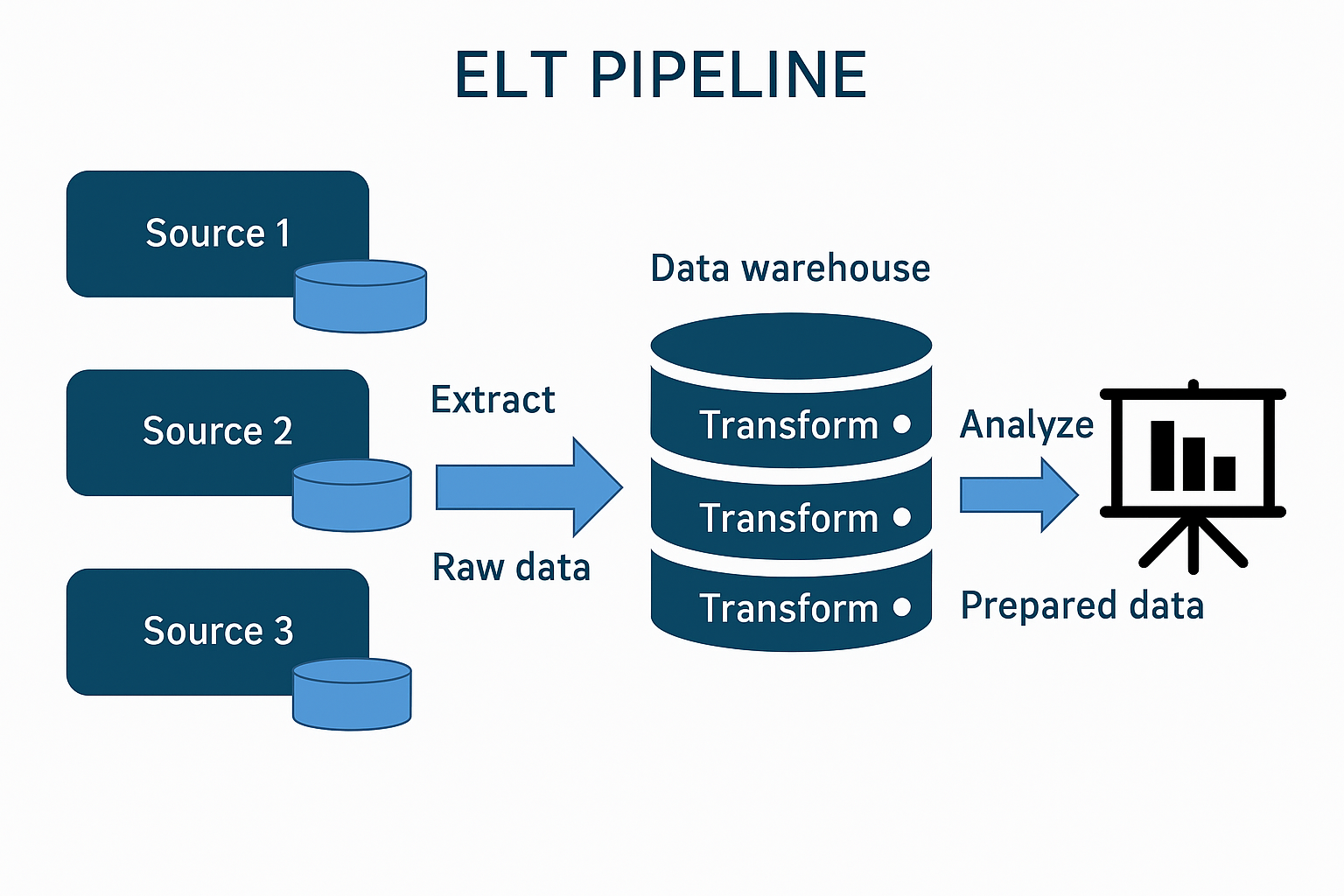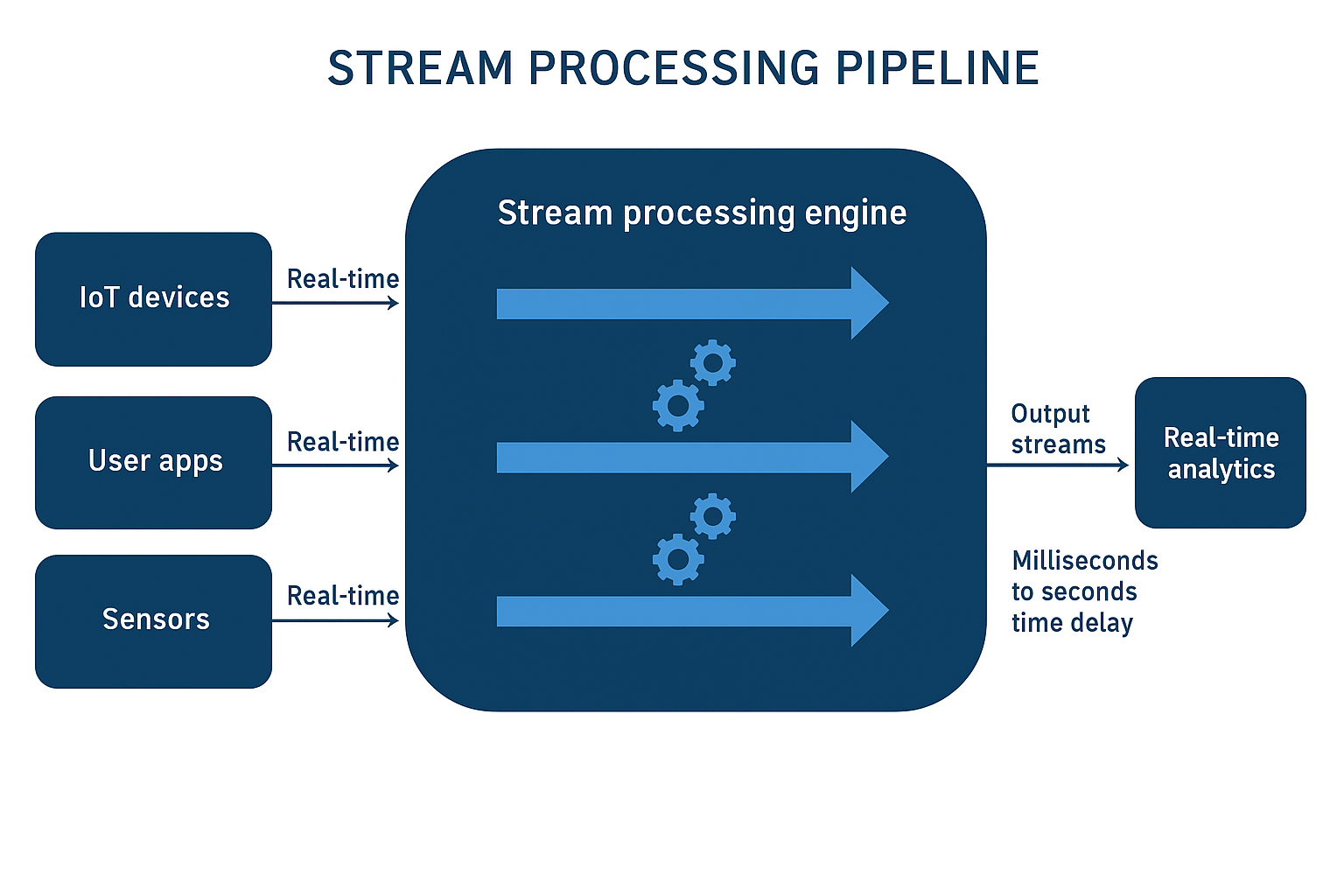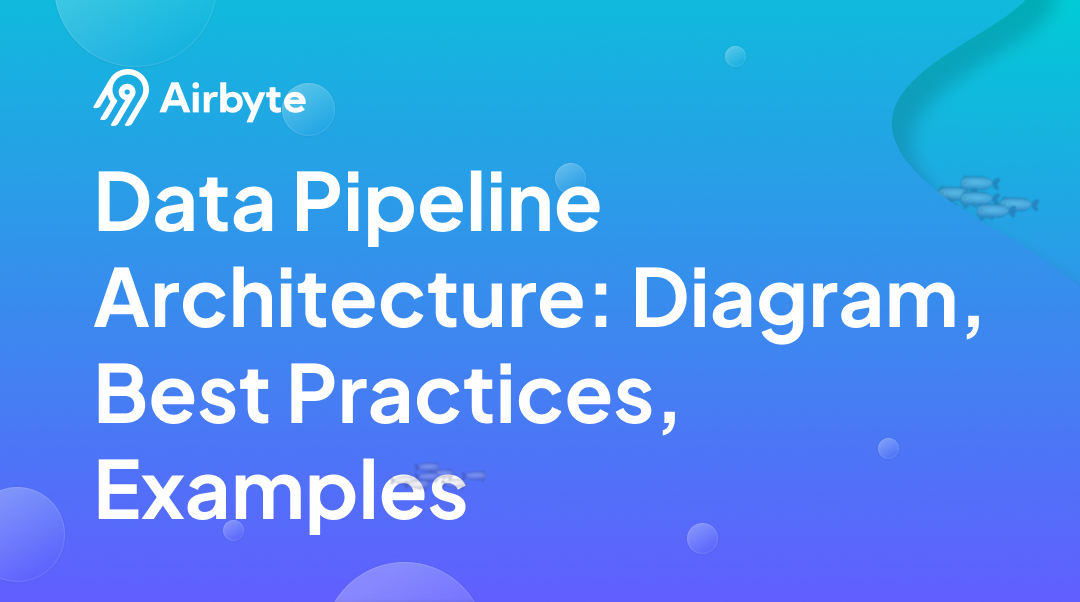Data Pipeline Architecture: Diagrams, Best Practices, and Examples
Summarize this article with:
✨ AI Generated Summary
Modern data-pipeline architectures address challenges of big data management by automating data collection, transformation, and loading to ensure data integrity, scalability, real-time processing, and cost optimization. Key pipeline types include ETL, ELT, streaming, batch, zero ETL, and cloud-native/serverless designs, each suited for specific use cases.
- Security-first architectures embed protection and compliance directly into pipelines, enhancing threat detection and reducing regulatory overhead.
- Autonomous operations with predictive intelligence enable self-healing pipelines that optimize resource use and minimize downtime.
- Effective pipeline design incorporates comprehensive monitoring, cost optimization, scalability, and disaster recovery from the outset.
- Tools like Airbyte simplify building robust ELT pipelines with extensive connectors, security features, and flexible deployment options.
Modern-day organizations often manage vast amounts of data generated from diverse sources such as IoT devices, social media, transactional systems, and customer interactions. However, traditional approaches to data-pipeline architecture face unprecedented challenges from escalating cyber-threats, regulatory complexity, and the demand for real-time AI-driven insights. Gathering this varied data for analyzing and deriving actionable insights presents significant challenges, especially for data transformations, integrity, and security.
Data pipelines can help overcome these challenges by automating the collection, transformation, and loading of data. This ensures that the data flows efficiently from its source to the storage and analysis platforms for effective utilization. A well-designed data-pipeline architecture can provide your organization with accurate and reliable data for improved operational efficiency and better decision-making.
Let's look into the details of data-pipeline architecture, including some best practices and examples for a better understanding.
What Is a Data Pipeline Architecture?
Data-pipeline architecture is the strategic design that defines how data is collected from various sources, processed, and delivered to its target systems. It is essentially a structure for efficiently moving data, transforming it as needed, and loading it into storage or analysis systems to meet specific requirements.
The two main approaches to designing data pipelines are ETL (Extract, Transform, Load) and ELT (Extract, Load, Transform). We'll explore these approaches in more detail in the next sections.
What Is the Importance of a Data Pipeline Architecture?
A robust data-pipeline architecture is crucial for effectively managing big data and addressing the challenges of the five Vs of big data—Volume, Velocity, Variety, Veracity, and Value. Each of these poses significant hurdles that a well-designed data pipeline can help overcome.
Key benefits
- Enhanced data integrity – A data pipeline automates the process of cleansing, validating, and standardizing data, ensuring that your data is clean, consistent, and accurate.
- Scalability – A well-designed data pipeline can accommodate increasing data loads seamlessly without compromising performance.
- Increased efficiency – Data pipelines streamline data movement by automating data flows, freeing up valuable resources for analysis, strategic planning, and decision-making.
- Cost optimization – Modern pipeline architectures reduce infrastructure costs by eliminating expensive licensing fees and reducing the engineering resources needed for maintenance.
- Real-time capabilities – Advanced pipelines enable real-time data processing and analysis, supporting immediate business decision-making and competitive response.
Essential Pipeline Diagram Components and Architecture Types
Selecting a data-pipeline architecture involves choosing one or multiple architectures to meet specific requirements. Understanding the pipeline diagram for each type helps visualize data flow and identify the best approach for your use case. Below are the common types of data pipelines with their corresponding pipeline-diagram structures.
ETL Pipeline Diagram and Architecture

The ETL data-pipeline architecture became predominant in the Hadoop era (roughly 2011-2017). In ETL, you extract data from various sources, transform it according to your operational needs, and load it into a destination system (data warehouses, databases, BI tools, cloud storage, etc.) for analysis and reporting.
The ETL pipeline diagram shows a sequential flow where transformation occurs before loading, which works well for structured data with well-defined schemas but can create bottlenecks when processing large volumes of diverse data types.
ELT Pipeline Diagram and Modern Architecture

The ELT data pipeline architecture has been gaining popularity since 2017. With ELT, data is extracted, immediately loaded into the destination, and then transformed as needed—offering more control, flexibility, higher computing speed, and reduced costs for advanced analytics.
The ELT pipeline diagram demonstrates how modern cloud data warehouses handle transformation after loading, leveraging powerful compute resources and enabling more flexible data processing workflows.
Stream-Processing Pipeline Diagram

Streaming data pipelines ingest and process data continuously in real-time or near-real-time. Tools like Apache Kafka facilitate high-throughput, low-latency stream processing. Data is often loaded directly into transactional systems or real-time dashboards.
This pipeline diagram shows continuous data flow essential for applications requiring immediate insights, such as fraud detection, real-time personalization, and IoT monitoring systems.
Batch-Processing Pipeline Diagram

Batch pipelines process large volumes of data at scheduled intervals (hours or days). They are often run during off-peak hours when immediate real-time processing isn't required.
The batch processing pipeline diagram illustrates how data accumulates before processing, making it ideal for historical analysis, reporting, and scenarios where processing delays are acceptable.
Zero ETL Pipeline Architecture
Zero ETL enables point-to-point data movement without traditional ETL steps, allowing real-time or near-real-time integration. It typically requires the transactional database and data warehouse to be on the same cloud provider.
This approach eliminates traditional pipeline complexity by enabling direct data access between systems, though it may limit flexibility compared to traditional ETL/ELT approaches.
Modern Cloud-Native Pipeline Diagram Architectures
Contemporary data pipeline architectures increasingly leverage cloud-native services and microservices patterns to achieve better scalability, reliability, and cost-effectiveness. These modern pipeline diagrams typically feature distributed components that can scale independently based on workload demands.
Serverless Pipeline Architecture
Serverless pipeline architectures utilize cloud functions, managed services, and event-driven processing to eliminate infrastructure management overhead. These pipelines automatically scale from zero to handle varying workloads while maintaining cost efficiency through pay-per-use pricing models.
Key components include event triggers, serverless compute functions, managed data storage, and orchestration services that coordinate complex workflows without requiring dedicated infrastructure management.
Multi-Cloud Pipeline Design
Organizations implementing multi-cloud strategies require pipeline diagrams that account for data movement across different cloud providers while maintaining security and governance standards. These architectures typically feature data federation layers, cross-cloud networking, and standardized APIs for consistent operations.
How Are Security-First Pipeline Architectures Transforming Data Integration?
The emergence of Security Data-Pipeline Platforms (SDPP) represents a fundamental shift in architectural design, moving beyond traditional bolt-on security measures to embed protection mechanisms directly into pipeline infrastructure. This transformation addresses the unsustainable costs of traditional SIEM licensing, regulatory pressures from evolving cyber-disclosure rules, and the telemetry explosion from IoT and AI applications.
The convergence of security and data engineering
Modern security-first architectures feature decoupled security-telemetry routing that enables simultaneous data feeds to multiple SIEMs, data lakes, and analytics platforms without source reconfiguration. This approach facilitates zero-downtime migrations and comparative analysis across security platforms. Detection-aware processing capabilities pre-process security logs to normalize schemas, enrich contextual metadata, and apply threat intelligence before ingestion.
Organizations implementing these architectures report significant improvements in threat-detection efficiency. The embedded compliance fabric automatically redacts PII, enforces retention policies, and generates audit trails for frameworks like GDPR and NIST 800-53, substantially reducing compliance overhead while ensuring consistent policy enforcement across distributed data environments.
Implementation of security-embedded pipeline architectures
Security-first pipeline architectures incorporate three core components that traditional approaches lack:
- Embedded observability probes – collect comprehensive pipeline metrics at frequent intervals, providing granular visibility into data-flow patterns and potential security anomalies.
- Remediation playbook repositories – contain pre-configured response protocols for hundreds of failure scenarios, enabling automated incident response without human intervention.
- Federated learning hub – continuously improves failure-prediction models across pipeline networks, applying machine-learning techniques to historical security-incident data to predict and prevent future threats.
This creates a self-improving security posture that adapts to evolving threat landscapes while maintaining operational efficiency across complex data environments.
Pipeline Monitoring and Observability Best Practices
Effective pipeline monitoring requires comprehensive observability across all stages of data movement and transformation. Modern monitoring approaches implement three layers of observability: infrastructure monitoring for resource utilization and system health, application monitoring for pipeline performance and data quality, and business monitoring for data freshness and business metric impacts.
Key Monitoring Metrics and Pipeline Diagram Integration
Pipeline diagrams should incorporate monitoring touchpoints at every stage, including data ingestion rates, transformation processing times, error rates, and destination loading performance. Implementing these monitoring points enables proactive identification of bottlenecks and failures before they impact business operations.
Advanced monitoring implementations include automated alerting based on statistical anomaly detection, predictive capacity planning using historical usage patterns, and integration with incident management systems for rapid response to pipeline failures.
What Role Do Autonomous Operations Play in Modern Data-Pipeline Management?
Self-healing pipelines represent the apex of operational automation, incorporating embedded intelligence that reduces pipeline downtime through predictive capabilities and automated remediation. These systems implement machine-learning models trained on historical pipeline-performance data to forecast failures well before occurrence, enabling proactive intervention rather than reactive troubleshooting.
Predictive intelligence and dynamic recovery
Autonomous pipeline operations feature predictive anomaly detection that analyzes patterns in data flow, resource utilization, and system performance to identify potential issues before they impact operations. When data-quality thresholds are breached or schema drift occurs, pipelines automatically divert data to quarantine zones, trigger validation scripts, and redeploy corrected versions without human intervention.
Resource-elasticity capabilities allow processing layers to autonomously scale based on workload patterns. Natural-language-processing workloads automatically receive GPU-allocation spikes during model-retraining cycles, while batch-processing jobs scale compute resources based on data-volume forecasts. This intelligent resource management optimizes costs while maintaining performance standards.
Practical implementation strategies
Organizations implementing autonomous operations typically start with automated error recovery for common failure scenarios before advancing to predictive capabilities. This incremental approach allows teams to build confidence in automated systems while maintaining control over critical business processes.
The most successful implementations combine automated operations with human oversight dashboards, enabling teams to monitor automated decisions while retaining the ability to intervene when business context requires manual decision-making.
Real-World Pipeline Diagram Examples and Case Studies
Efficient data pipelines automate the flow of data, ensuring consistency and integrity. Below are real-world implementations that demonstrate effective pipeline diagram principles in action.
Fox Networks' resilient data-pipeline architecture

Fox Networks combines streaming and micro-batch processing (Apache Spark + AWS) to ensure real-time data access during critical events like the Super Bowl. They leverage Datadog, Monte Carlo, and PagerDuty for monitoring and incident management while promoting self-service analytics.
Their pipeline diagram demonstrates redundancy and failover capabilities essential for high-stakes live events, where pipeline failures could impact millions of viewers and significant advertising revenue.
Swimply's scalable data-pipeline architecture

Swimply prioritizes automation and scalability with Fivetran, Snowflake, dbt, Monte Carlo, and Looker—consolidating data from multiple sources into a single source of truth while minimizing infrastructure-management time.
Their approach demonstrates how modern ELT architectures enable rapid scaling without proportional increases in operational overhead, supporting business growth through automated data operations.
Cost Optimization Strategies for Pipeline Architecture
Modern pipeline architectures must balance performance requirements with cost constraints, especially as data volumes continue growing exponentially. Effective cost optimization strategies include implementing tiered storage architectures, optimizing compute resource allocation, and leveraging spot instances for non-critical workloads.
Resource efficiency and pipeline design
Pipeline diagrams should incorporate cost optimization touchpoints, including data lifecycle management policies, compute resource scheduling, and storage tier optimization. Organizations typically achieve 30-50% cost reductions through strategic pipeline design that matches resource allocation to actual usage patterns rather than peak capacity requirements.
Advanced implementations include automated cost monitoring with budget alerting, resource right-sizing based on historical usage analysis, and intelligent scheduling that leverages lower-cost computing resources during off-peak hours.
Best Practices for Designing Effective Pipeline Diagrams
- Determine your data sources – know the format, structure, and volume of each source to design appropriate ingestion strategies.
- Map data dependencies – use automated data-lineage tools to visualize the data flow and identify critical dependencies.
- Implement comprehensive monitoring – design monitoring touchpoints into your pipeline diagram from the beginning rather than adding them as afterthoughts.
- Plan for data quality – implement quality checks from the entry point onward (missing values, anomalies, duplication) with clear remediation paths.
- Ensure disaster recovery – adopt distributed storage and regular backups with documented recovery procedures to minimize downtime.
- Prioritize security – enforce encryption, strong access controls, and comprehensive data-governance throughout the pipeline architecture.
- Design for scalability – anticipate growth in data volume, velocity, and variety when creating your pipeline diagram architecture.
- Regular testing and optimization – continuously test transformations and performance to stay aligned with evolving business objectives.
- Document pipeline flows – maintain clear pipeline diagrams and documentation for troubleshooting and onboarding new team members.
How Can You Build Robust Data Pipelines with Airbyte?
Manually building data pipelines demands extensive custom coding and ongoing maintenance overhead. Airbyte is an open-source ELT platform that simplifies pipeline creation with more than 600+ built-in connectors, enabling organizations to implement sophisticated pipeline diagrams without the traditional development complexity.

Key features for modern pipeline architecture
- Extensive connector ecosystem – pre-built connectors eliminate custom development time while ensuring reliable data integration across diverse source systems.
- Custom connector development – build missing connectors via the Connector Development Kit (CDK) or use the AI Assistant to generate working connectors from API-documentation URLs in seconds.
- Change Data Capture (CDC) – capture source changes and reflect them downstream in near real time for event-driven architectures.
- Enterprise-grade security—including comprehensive audit logging, end-to-end encryption, robust access controls, and SOC 2, GDPR, and HIPAA compliance—is available in Airbyte Cloud and Enterprise editions. For self-hosted/open-source deployments, users are responsible for meeting these security and compliance requirements.
- Advanced transformations – integration with dbt for advanced transformations and PyAirbyte for Python developers building data-enabled applications.
- Vector-database support – direct integration with vector databases for GenAI workloads and LLM-training pipelines.
- Flexible deployment options – choose from Airbyte Cloud (fully managed), Self-Managed Enterprise, or open-source deployment for maximum customization and control.
- Cost optimization – open-source foundation eliminates licensing costs while reducing operational overhead compared to traditional ETL platforms.
Airbyte's approach addresses the fundamental challenges organizations face when choosing between expensive proprietary solutions and complex custom integrations, providing enterprise-grade capabilities without vendor lock-in or unsustainable operational costs.
Final Thoughts on Data-Pipeline Architecture
Data pipelines are essential for moving data from source to destination, enabling timely analysis and informed decision-making. This article covered the evolving landscape of pipeline architectures, from traditional ETL approaches to modern cloud-native and autonomous systems. Understanding different pipeline diagram configurations and their appropriate use cases enables organizations to select architectures that align with their specific requirements and constraints.
Modern pipeline architectures increasingly emphasize security-first design principles, autonomous-operations capabilities, and flexible deployment models that support both traditional batch processing and real-time AI-driven analytics. The integration of comprehensive monitoring, cost optimization strategies, and automated operations represents the future direction of data pipeline architecture.
Organizations that embrace these emerging paradigms while maintaining focus on practical implementation will be better positioned to leverage their data assets for competitive advantage. The key lies in balancing technological sophistication with operational simplicity, ensuring that pipeline architectures enable rather than constrain business innovation.
The future of data-pipeline architecture lies in intelligent, self-managing systems that automatically adapt to changing business requirements while maintaining robust security and governance standards. Success requires careful attention to pipeline diagram design, monitoring integration, and cost optimization from the initial architecture phase rather than attempting to retrofit these capabilities later.
FAQs
What should be kept in mind before designing a data pipeline?
Consider pipeline scheduling, data-quality checks, data-load characteristics, storage goals, security/compliance, scalability for future growth, monitoring requirements, and cost optimization strategies. Create a comprehensive pipeline diagram that accounts for all these factors.
What is the difference between ETL and a data pipeline?
A data pipeline is any system for transferring and processing data from one or more sources to a destination. ETL is a specific pattern for such pipelines—extract, transform, and load—so while all ETL workflows are data pipelines, not all data pipelines are ETL.
How do I choose between different pipeline diagram architectures?
Choose based on your specific requirements: ETL for well-structured data with complex transformations, ELT for cloud-native architectures with powerful destination compute, streaming for real-time requirements, and batch processing for large-volume periodic processing. Consider factors like data volume, latency requirements, infrastructure capabilities, and cost constraints.
What monitoring should be included in a pipeline diagram?
Include monitoring touchpoints for data ingestion rates, transformation processing times, error rates, data quality metrics, resource utilization, and destination loading performance. Implement alerting for anomalies, failures, and performance degradation with clear escalation procedures.

.webp)
